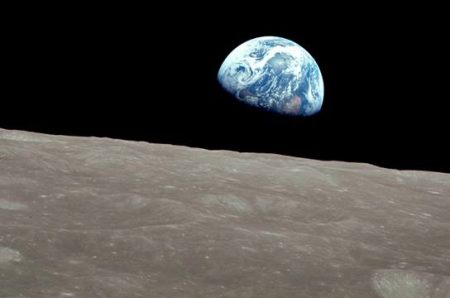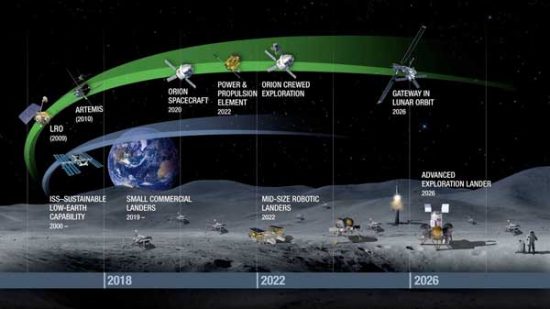December 7, 2018 – Last week NASA rolled out its business plan for the Lunar Orbital-Platform Gateway, a project to build a space station orbiting the Moon. Whether this idea makes sense or not, NASA has promoted it as the next big thing and has opened up the floodgates to commercial space companies to help make it happen. One expects to see Lockheed Martin on the list but where are SpaceX, Blue Origin, and Bigelow? Apparently, all three did not make the cut from the 30 companies that were solicited by NASA in May of 2018 to fulfill a request for proposals from the private sector for a return to the Moon.
All companies that made it past NASA’s first benchmark have been asked to have plans in place by early 2019, and first deliveries scheduled for no later than the end of 2021. Among the technology NASA wants are landers and rovers capable of carrying scientific instrumentation, and robot explorers for prospecting.
Here are what NASA hopes will become its latest space wunderkind:
Astrobotic Technology, Inc., based in Pittsburgh, Pennsylvania, is developing launch capability for companies building hardware systems to go into space. Spun out of Carnegie Mellon University in 2007, NASA has given the company two contracts for developing new landing technologies to make the Moon more accessible. On its website the company is offering services to deliver payloads to the lunar surface for the price of $1.2 million US per kilogram ($545,000 per pound).
Deep Space Systems Inc., based in Littleton, Colorado, a systems engineering company since 2001, that largely focuses on sub-assemblies associated with space missions, has built camera systems for scientific deep space missions including the Mars Reconnaissance Orbiter, the Phoenix Mars Lander, and the Juno Mission around Jupiter. The company is a close collaborator of nearby Lockheed Martin.
Draper, based in Cambridge, Massachusetts, has been working with NASA going back to the Apollo Program of the 1960s. The company is an engineering firm contracted to support NASA’s lunar payload services program and is building Artemis-7, a robotic lunar lander to do sampling and return missions on the Moon. The design specifications call for more than one-time use.
Firefly Aerospace, Inc., based in Austin, Texas, is a builder of rockets capable of putting medium-sized payloads from 1,000 to 4,000 kilograms (2,200 to 8,800 pounds) into low-Earth orbit. For the return to the Moon NASA has awarded the company a contract to deliver scientific and commercial payloads to the lunar surface from launch to landing on the Moon. The company is partnering with Intuitive Machines.
Intuitive Machines, LLC, based in Houston, Texas, is the developer of the Nova-C Lunar Lander designed for multiple landings and takeoffs on the Moon’s surface. Nova-C can carry up to seven different payloads totaling at least 85 kilograms (about 200 pounds) in capacity per single flight. The autonomous spacecraft delivers power, computation, and data relay services for each payload when it lands. Nova-C can also release small satellites into lunar orbit prior to landing which makes it ideal for setting up an orbit-based lunar communications network. The company expects to land its first payload on the Moon in 2021.
Masten Space Systems, Inc., based in Mojave, California, is a builder of reusable rocket technology. Founded in 2004, the company participated and won the Northrop Grumman Lunar Lander Challenge in 2009. In the last five years it has worked with NASA on the Lunar CATALYST program. Its first lunar vehicle is the XL-1 which features 2 payload bays and a capacity to deliver 100 kilograms (220 pounds) to the Moon’s surface. The timetable for the first launch is 2021.
Moon Express, based in Cape Canaveral and founded in 2010, the company is the developer of the MX series of landers. The first mission, named Lunar Scout, will include a payload containing the International Lunar Observatory as well as other instrumentation. The second planned mission called Lunar Outpost will explore the lunar South Pole, prospecting for water and other useful materials. The planned third expedition, Harvest Moon, will be a sample return effort for commercial and science-based customers. Moon Express has also been working with NASA on Lunar CATALYST.
ORBITBeyond, based in Edison, New Jersey, is the developer of the Z-01 capable of delivering commercial payloads of up to 50 kilograms (110 pounds) to the lunar surface. It has its first planned launch scheduled for early 2020 when it will deliver a science and technology payload to the Mare Ibrium on the lunar surface. A second generation lander, the Z-02 will handle payloads of 500 kilograms (1,100 pounds) with the ability to land anywhere on the Moon’s surface from highlands to the bottoms of craters. The Z-02 will deploy direct-to-Earth transmission and will have a robotic arm.
Many of the companies that NASA has chosen from its request for proposal announcement were entries in the now-ended Google Lunar XPrize. And although no company was able to meet the deadline of that challenge, the technologies developed and the progress made will now find a new opportunity in sharing up to $2.6 billion in NASA awarded contracts.
But one shouldn’t be surprised if Lockheed Martin has the inside track for much of the money slated for NASA’s return to the Moon. The company already has a lunar lander in the works based on Insight, the lander that recently touched down on Mars. The company built the Phoenix Lander which was successfully deployed on Mars back in 2008. It has recently unveiled a crewed lunar lander prototype designed to support human expeditions to the surface for up to two weeks. And of course, Lockheed Martin is very much involved in the Lunar Orbital Platform Gateway itself, which will serve as home base for much of the planned lunar activity associated with the $2.6 billion NASA currently has up for grabs.

















